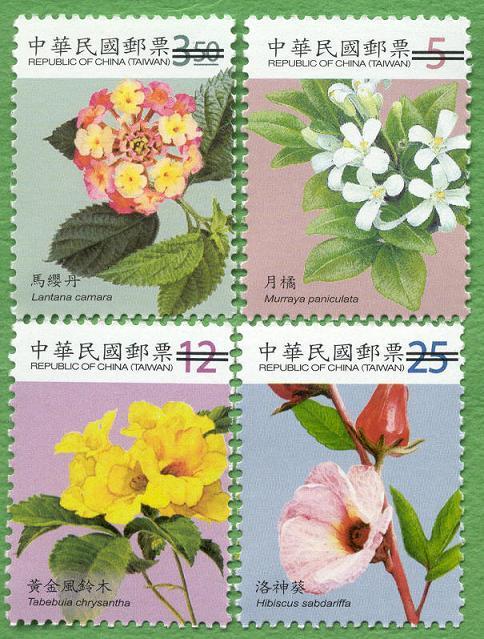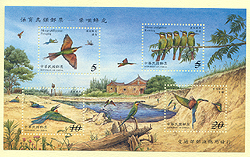

About Postcards
- Taipei 101 ::: Taipei 101 is the tallest building in the world, with a mass of shops on the lower floors, incorporating many top brands under the LVMH group, such as Louis Vuitton, Dior, Celine, etc. The fourth floor houses the Page One bookstore from Singapore, with the highest-roofed coffee house in Taipei and many fine restaurants. (See more)
- Chiang Kai-shek Memorial Hall ::: Chiang Kai-shek Memorial Hall is located in the heart of Taipei City. The area is 250,000 square meters and it is the attraction most visited by foreign tourists. Outside the gate of Chiang Kai-shek Memorial Hall, there are poles carrying the sign of true rightness. The architecture of Chiang Kai-shek Memorial Hall is inspired by Tiantan in Beijing. The four sides of the structure are similar to those of the pyramids in Egypt. The material is white marble. The roofs are decorated with deep-blue glass as part of the reflection of blue sky and bright sun. It adds a touch of grandeur. The garden is planted with red flowers. As a whole, the colors of blue, white and red express the National Flag and the spirit of freedom, equality and brotherhood. The great building has become a landmark of Taipei City. There are also places for international art performances. They are National Theater and National Concert Hall. World famous musicians (such as the great cello performer Yo Yo Ma and the great violinist Shao Lian Lin) and renowned playgroups have conducted performance here. The garden with beautiful flowers, miniature hills and plants, ponds, ornamental bridge and waterfalls as well as green grass presents scenery beauty. The walls surrounding the area are with nostalgic design. The place is enriched with the beauty of traditional Chinese gardens. There are various activities taking place in the square. There are the concert of the world renowned three tenors, school band performances, cheerleader performances and fairs. One can pay respect to the historical great leader, as well as participate in the relaxation activities of local residents. The place provides a precious plain view among the tall buildings of Taipei.
About Stamp (CR#Taiwan Postal Stamps Mall)
Issue Name ::: Flowers Postage Stamps (I)
Issue Date ::: 2009-03-12
Detail ::: The colors and shapes of Taiwan’s flowering plants are varied. To introduce the beauty of Taiwan’s flowers, Chunghwa Post is issuing a series of definitive stamps on flowers. The first set of four stamps features the following flowers: Lantana camara, Murraya paniculata, Tabebuia chrysantha and Hibiscus sabdariffa. Details of these stamps are as follows:

- Lantana camara (NT$3.50): Lantana camara is an evergreen shrub of the Verbenaceae family. Its leaves are opposite and ovate and both the leaves and stems have unpleasant acrid odors. The flowers are arranged in flat heads. The lantana is a popular ornamental plant because it flowers for a long and sustained period. Its fruit, leaves and stems are poisonous and therefore should not be eaten.
- Murraya paniculata (NT$5.00): Also known as orange jasmine or Chinese box, Murraya paniculata is an evergreen shrub of the Rutaceae family. Its small alternate leaves are ovate and glossy. White and campanulate, its corymbose flowers, each with five petals, are highly fragrant. Its wood is fine and hard and suitable for making seals. It is a widely planted ornamental.
- Tabebuia chrysantha (NT$12.00): Also known as golden goddess, Tabebuia chrysantha is a deciduous tree of the Bignoniaceae family. Its small leaves are opposite and obovate. Funnel-shaped, its bright yellow corolla are grouped in panicles with wrinkly edges. Care should be taken to avoid touching its flowers or fruit since contact might cause skin irritation or an allergic reaction.
- Hibiscus sabdariffa (NT$25.00): Also known as rosella, Hibiscus sabdariffa is an annual herbaceous subshrub of the Malvaceae family. Its leaves are alternate and have thick hair on both sides. With petals that are imbricate, the plant’s flowers open light yellow and age to pink. Its large and fleshy calyces are bright red and quite nutritious. The calyces are quite flavorful once they are dried and cooked.

Issue Name ::: Conservation of Birds Postage Stamps-Blue-tailed Bee-eaters S.S.
Issue Date ::: 2003-05-08
Detail ::: To promote a better understanding about ecological conservation and to raise the image of R.O.C. internationally for its conservation efforts, the Chunghwa Post is taking the bluetailed bee-eater, a protected summer migratory bird species in Kinmen National Park, as the topic for a set of four stamps as well as a souvenir sheet. The blue-tailed bee-eater (Merops philippinus) belongs to the order Coraciiformes, family Meropidae. The family Meropidae consists of 25 species. More than 30 countries in the world have taken some ten of these species as subjects of bird stamps. Including their tail feathers, blue-tailed bee-eaters are about 30 centimeters long. They look very beautiful with their black eye stripes, sharp and pointy bills, red throats, green backs and blue feathers. They are very nimble and often catch their prey in flight-behavior that has earned them the nickname “hunters on the wing.” They come to Kinmen to breed during April and May every year. Their colorful plumage adds many beautiful colors to the summer sky of Kinmen, and the sight of them in flight is enjoyed very much by bird watchers. The designs of the four stamps follow:

- Foraging (NT$5.00): The blue-tailed bee-eater is a typical insect-eating bird. Its diet includes excellent flyers like dragonflies, bees and butterflies. Ecologically, the blue-tailed bee-eater helps to control insect populations and maintain diversity of insect species.
- Roosting (NT$5.00): The blue-tailed bee-eaters normally go about and forage in small groups, seeking protection in numbers. They are often seen on the power lines and tree branches near fields and woods. They communicate with their flute like calls.
- Bathing (NT$10.00): The blue-tailed bee-eaters live in holes dug out in the earth and are prone to be infected with parasites. At noon, the bee-eaters lie on the ground spreading their wings to expose their bodies to the sun and use the heat of the hot sand to drive away the parasites in their feathers.
- Feeding Chick (NT$20.00): It takes about a month for bee-eaters to rear their chicks. During this time, the parents go out to catch insects to feed their chicks. Any insects that can fly can become food for the chicks. The parents are very busy during this period, and the chicks often fight each other for food at the opening of their nests.

Issue Name ::: Flowers Postage Stamps (II)
Issue Date ::: 2009-10-14
Detail ::: Having issued the first set of definitive stamps on flowers on March 12, 2009, Chunghwa Post is going to follow up with a second set, featuring Calliandra emarginata, Bombax ceiba, Delonix regia, and Spathodea campanulata. This set of stamps was organized by Dr. Heng-piao Chin, the former director-general of the Taiwan Forestry Research Institute, Council of Agriculture of the Executive Yuan, and Dr. Ting-Fang Hsieh, director of the Floriculture Research Center, Agricultural Research Institute, Council of Agriculture of the Executive Yuan. The stamps were painted by Mr. Hung-tu Ko, and printed by Central Engraving and Printing Plant in color deep-etch offset. The set of four stamps will be released on October 14, 2009. Details of these stamps are as follows:

- Calliandra emarginata (NT$1.00): Calliandra emarginata, or powder puff, is a semi-deciduous shrub of the Fabaceae family. Leaves are bipinnately compound, with oval lanceolate leaflets. The leaflets fold together at night and unfold during the day. The inflorescence is axillary and capitulum. The corolla is semicircular, with dense long filaments, resembling a powder puff. It is a very good ornamental specimen.
- Bombax ceiba (NT$2.50): Bombax ceiba, commonly known as cotton tree, is a deciduous tree of the Bombacaceae family. Leaves are palmately compound. Flowers are orange or red, with five petals. The calyx is cup-shaped. It produces a capsule which, when ripe, will burst open and disperse seeds that are covered thickly with cotton-like fibers. The tree has a masculine shape and looks different in all four seasons. One of its salient features is that it blooms before it leafs out.
- Delonix regia (NT$10.00): Delonix regia—which is commonly known as royal poinciana, flamboyant, or flame of the forest—is a deciduous tree of the Leguminosae family. Most of them have buttress roots. The tree has an umbrella-shaped crown. Leaves are opposite and bipinnately compound. Each of its flowers, which are arranged in terminal racemes, has five petals, which are bright red with a touch of yellow, and its filaments are slender and red. Because the tree blooms in June, it is often used to symbolize graduation. The royal poinciana is a large tree and mainly used for firewood, or as an ornamental or street tree.
- Spathodea campanulata (NT$32.00): Spathodea campanulata, or fountain tree, is a deciduous tree of the Bignoniaceae family. Leaves are opposite and pinnately compound, with oval leaflets. The inflorescence is in the form of a terminal panicle, with the outer buds blooming first. The flowers are orange scarlet, resembling flames on the crown of the tree. The fountain tree loves heat and sun light. It is commonly grown as a street tree and garden specimen.
Thanks ::: Chen Kang (jerry2610tw)










